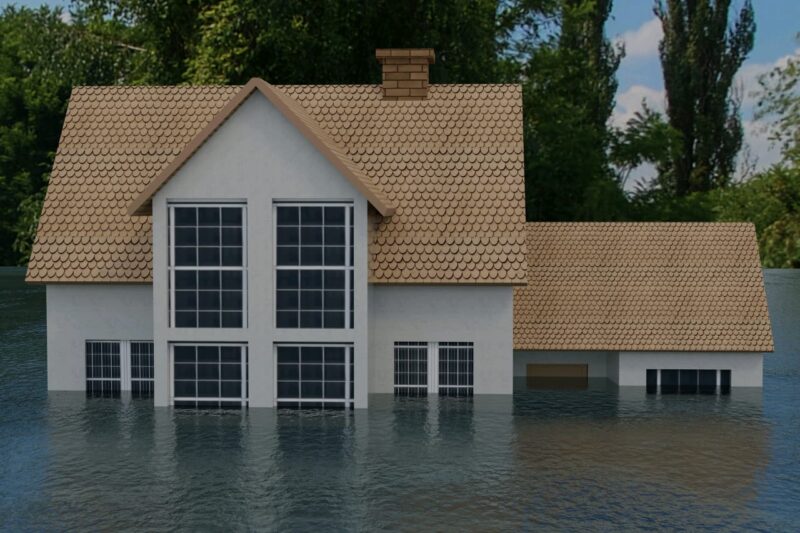We’ve all had nightmares about waking up to a basement full of water. Everything from family photos to a spare chest of drawers full of kids’ clothing lost, and untold damages that we’ll have to fix.
As there is nothing we can do to alter Mother Nature’s path, major floods, and unexpectedly high water levels will always be a cause for worry for homes, particularly those with basements or ones in states with higher risks of floods.
However, every time it rains, you shouldn’t have to deal with a basement flood. If this is an issue, there are measures you may do to safeguard your subterranean recreation room, workout space, theater, or storage facility.
Keep on reading to learn all about the best seven strategies you can implement to aid in preventing basement flooding.
1. Basics of Avoiding a Basement Flood: Grade Your Lawn
Basement flooding is possible if the yard surrounding the house grades or slopes toward the house rather than away from the house.
The water that falls from the sky must go somewhere. Your yard should have a gentle incline that directs rainfall away from your house and onto the street or storm drain.
In case you take a stroll about your property and observe that the grass begins to slope in the direction of the walls, there are a number of landscaping adjustments that need to be made. The good news is that you have some leeway to be creative with how you reduce flood danger, so you can make it work with your preferred aesthetic.
Attempt these approaches to landscaping and see what works for you.
- Installing a rain garden;
- Digging out a swale;
- Adding heavier mulch;
- Getting a green roof;
- Add space between your siding and your mulch.
This is particularly true of siding and other exterior finishes that aren’t as water resistant as brick.
2. Understanding Your Home Terrain: Take a Stroll Around Your Yard
Water from rainstorms seeps rapidly into the earth and eventually your basement. If you want to know why your basement always floods when it rains, you should take a trip around your house’s perimeter when it’s raining and observe where the water goes as it hits different surfaces.
Since it may be difficult to get a contractor out there during a storm, it is a good idea to take images to serve as a visual reminder or to show the contractor what is happening. In addition, you can learn about the cost to waterproof a basement here.
3. Direct Downspouts Away From Your Home
If your downspouts currently connect to a footer drain or terminate just above the ground surrounding your house, you may divert the water away from the foundation by adding extra material to the spout.
So that water doesn’t just run back toward your outside walls and sit, be sure to divert it onto grass areas that are graded away from your house. If the earth becomes saturated during times of high precipitation, the basement may flood.
4. Regularly Clean Your Drains
Drains in the floor, which serve to divert excess water away from buildings and reduce the risk of flooding and other water damage, may get blocked with debris over time.
Because of this, water that does make its way into your basement may accumulate and eventually create flooding. The likelihood that your basement may flood can be reduced by keeping the drains clear of debris.
5. Maintain Your Gutters
Unfortunately, the reality cannot be ignored. The gutters are clogged with leaves and sticks. They might cause floods in your house if you don’t clear them out periodically.
If your gutters are clogged, water may overflow and pool just below them, damaging your home’s foundation during a downpour. Rainfall intensifies as a result of these obstructions since the water has nowhere else to go but to the ground.
Like the bucket drop at your favorite water park, this force will drench your foundation with torrential rain, but this time it won’t be enjoyable and refreshing.
6. Put in a Sump Pump and a Backup Sump Pump
A sump pump is like a big drain that removes water from your basement during storms and regular seepage.
In the deepest part of your basement, you should put a portable pump. A permanent sump pump installed below-grade requires regular maintenance, including maintaining its well clear of debris to ensure the pump can accomplish its job of keeping the basement dry.
If the storm that causes your basement to flood is also the one that takes out your power, you will be ready with a backup sump pump that runs on batteries. The same effect may be achieved by connecting it to an emergency generator.
7. Test Your Sump Pump in the Off-Season
An operational sump pump is your best bet for keeping your basement dry during the wet months. The purpose of a sump pump is to remove groundwater from the area around a basement and channel it to an outside drainage system or pond, preventing water from seeping in through the foundation.
If you have a sump pump, you should check it out by filling a 5-gallon bucket with water and dumping it into the pit. Normally, the pump will activate by itself, drain the majority of the pit’s water, and then shut off. In order to avoid the power cable becoming caught in the float switch and preventing the pump from starting, make sure it is connected in and secure.
How to Prevent a Basement Flood: Simplified
Preventing basement flooding is preferable to cleaning up after it has already occurred, so be sure to do routine checks and maintenance on your house or other property. We hope that our guide has given you a solid starting point with our seven tips on avoiding a basement flood.
Next, you’ll want to check out our home improvement section for more tips and advice on designing and fortifying your basement.










